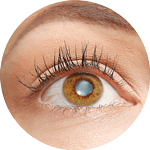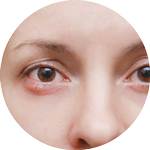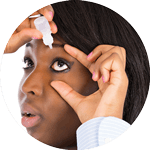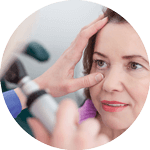Patient Education

Presbyopia
A problem that occurs to everyone! Around the age of 40, your near vision, or reading vision, may start to decline, even if you have good distance vision. This is a normal age-related change to your eyes. Over the counter reading glasses are an easy way to help this problem, but always best to have a comprehensive eye exam to see if prescription glasses are better for your vision.

Nearsightedness (Myopia) / Farsightedness (Hyperopia)
Nearsightedness means your natural focal point (where you can see best without glasses) is better at near than at distance. Farsightedness means your natural focal point is better for distance than at near. Both of these problems can affect patients of all ages, and prescription glasses or contact lenses are needed to help this problem.

Astigmatism
Astigmatism can result in blurry or distorted vision at distance and at near. This is because the natural curvature of your cornea (the clear window on the front of the eye) is more irregular in shape. A good example is your cornea has more football shape and a uniform basketball shape. Sometimes if a cataract has developed, this can cause irregularity to the lens inside of the eye, also contributing to astigmatism. Glasses, contact lenses, or lens implants with cataract surgery can help to alleviate this problem.

Cataracts
Cataracts are one of the leading causes of vision loss in adults over the age of 55. A cataract occurs when the native lens inside of the eye becomes cloudy, with age-related reasons being most common. Symptoms include gradually worsening night vision, glare, and difficulty with distance and reading vision. Cataract surgery is the most definitive way to treat a cataract. This procedure has a very high success rate and can potentially reduce or eliminate your need for glasses for distance and/or near vision. The doctors at the Eye Center of Charleston offer the latest cataract surgery treatments to help improve your vision, including astigmatism and presbyopia-correcting lenses.

Glaucoma
Glaucoma is a disease where the optic nerve is damaged inside of the eye, causing peripheral vision loss and even central vision loss if the disease is advanced. There may be no symptoms in the early stages of the disease. High eye pressure is the most significant risk factor in developing glaucoma, although increased age, family history and African-American heritage are risk factors as well. If diagnosed early, blindness from glaucoma can be preventable, therefore early detection and treatment is extremely important. The doctors at the Eye Center of Charleston are experienced in the medical, laser-assisted, and minimally-invasive surgical treatment of glaucoma.

Diabetic Eye Disease
The American Diabetes Association recommends that all diabetic patients have a dilated eye exam at least once a year. Early signs of damage in the body from diabetes can appear in the retina, known as diabetic retinopathy. Mild retinopathy is described by swelling and/or bleeding in the retina, while severe retinopathy can lead to retinal detachment and irreversible vision loss. Therefore, it is very important to be screened by your ophthalmologist to detect early signs if present.

Stye / Chalazion
A stye, also known as a hordeolum, is a localized infection in the eyelid, arising from oil glands or eyelash follicles. A chalazion is a localized area of chronic inflammation in the eyelid, usually related to poorly functioning oil glands. Frequent warm compresses and improving eyelid hygiene with baby shampoo scrubs or over-the-counter scrubs can alleviate these problems. Some stye and chalazia can respond to topical eyedrops prescribed by your ophthalmologist.

Dry Eye Syndrome
Dry eye syndrome is one of the most common reasons patients visit their ophthalmologist, with thousands of people affected each year. Any disturbance in the tear film, a thin layer of moisture that lubricates the surface of the eye, results in symptoms of dry eye. These can range from intermittent blurry vision, inability to tolerate contact lenses, sensitivity to light, gritty sensation, stinging, burning, tearing and eye redness. There are various causes of dry eye, such as hormonal changes, medications (usually anti-allergy medications and some blood pressure medications), climate changes, inflammation in the body and occasionally overactive nerves that provide sensation to the eyes. The overall quality of the tear film does diminish with age as well. Initial therapy for dry eye is targeted to over-the-counter artificial tears and warm compresses, but sometimes patients need more intensive therapy. It’s important to know that every case of dry eye and every patient is different, therefore talk with the doctors at the Eye Center of Charleston to find the right treatment plan for you.

Excisional Lid Biopsies
The doctors at Eye Center of Charleston are trained to perform eyelid biopsies in the clinic. New or existing skin lesions occurring around the eyelid can range from benign growths to skin cancer. Please have a thorough exam with your ophthalmologist if this problem arises.

Floaters and Flashes
Floaters most commonly occur when the jelly inside of the eye, known as the vitreous, clumps together and floats around inside of the eye. This is a very common problem. The retina can be described as the “camera film” inside of the eye, which helps capture and send visual information to the brain. Flashes can occur when the vitreous pulls too hard on the retina, causing a tear, and possibly a retinal detachment. If you experience an increase in the number and frequency of floaters or new flashes, please have a dilated eye exam as soon as possible.

Macular Degeneration
Age-related Macular Degeneration, also known as AMD, occurs when the central part of the retina, known as the macula, undergoes damaging, age-related changes that affect central vision, sparing side vision. Age, genetics, and smoking are several significant risk factors for developing this disease. There are two forms of AMD, “dry” and “wet.” “Wet” AMD typically refers to bleeding and leaking of fluid in the central retina, which can cause a very rapid decrease in central vision. There is no cure for AMD, but certain eye vitamins, dietary changes, lifestyle changes, and other medical treatments are available that can decrease the risk of further vision loss from AMD.

Copyright 2021-2024 by Eye Center of Charleston